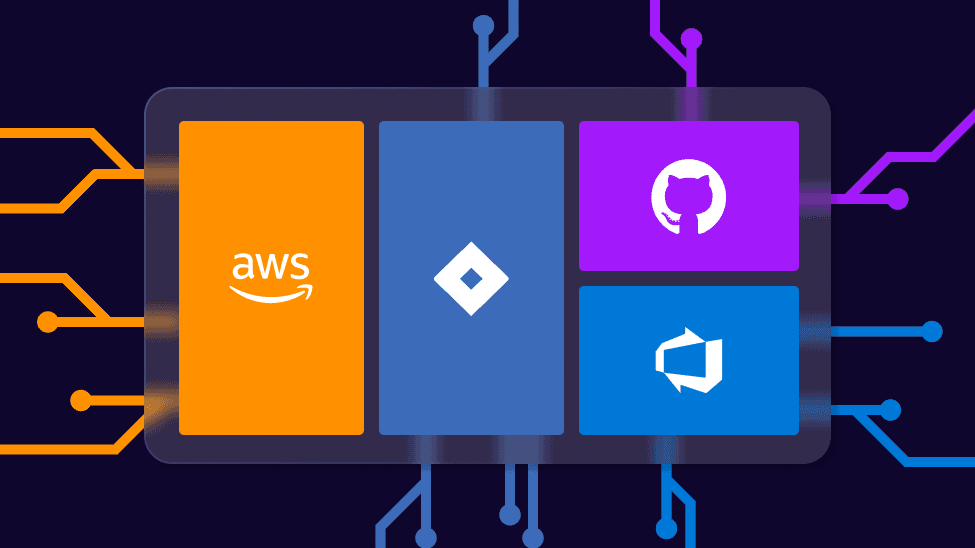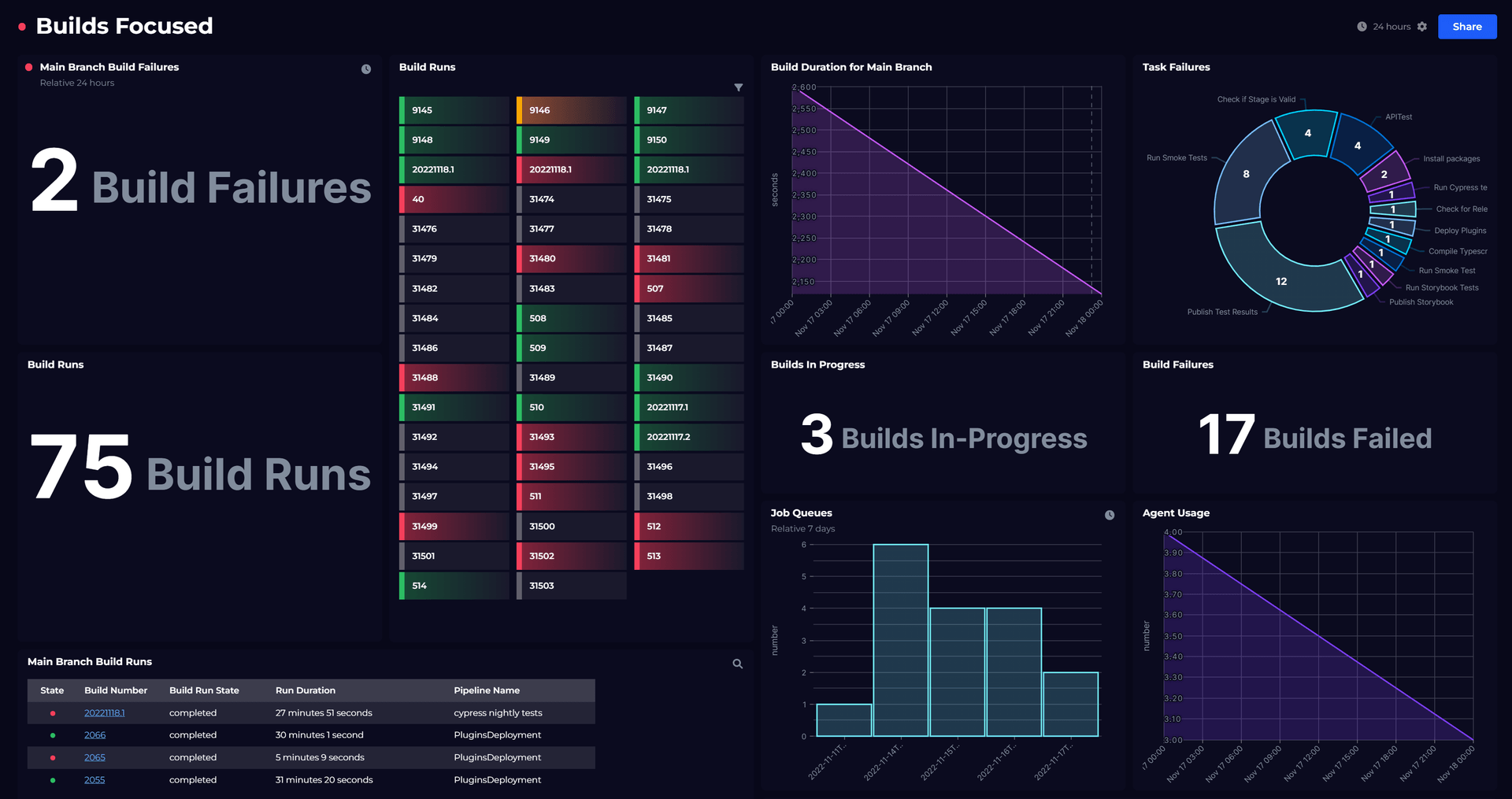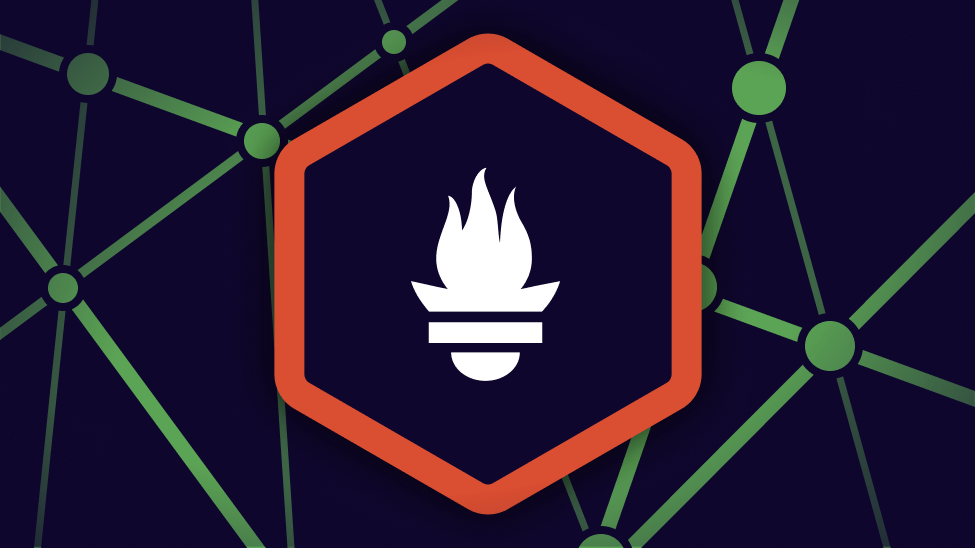
How to build the ideal engineering team dashboard
Create free accountEngineering teams of today use a plethora of tools to perform different functions in the software development life cycle. While tools like Slack, Teams, etc. are great for quick notifications, they rarely give you a comprehensive view of the things in current state.
Sure, you can switch between tabs for all your tools but an "Engineering dashboard" that brings this all together makes it much easier to consume quickly and effectively. A dashboard can also be used to share status outside of the team – with managers who may not have access to all of the underlying tools or don’t have the time to go digging.
What does an ideal engineering dashboard look like?
Every software development team is different. Depending on your role and your organization, an engineering dashboard could contain any of the following types of metrics:
- Application performance
- Cloud platform
- Workflow management
- DevOps
- Cost
Necessary features
While only you can answer the question as to what metrics serve you best, there are dashboarding 101 basics that are applicable across most use cases. Your dashboard needs to offer the following:
- Integration with your full tech stack that is seamless and affordable
- Instant access to data that doesn't require additional steps such as re-running scripts
- Data visualization options to help users understand data and analyze trends
- Customizable notifications that alert users about critical events via their channel of choice (email, Slack, ServiceNow, etc.)
- Easy sharing with stakeholders whether or not they have access to the underlying technical data
- Security features including strong authentication mechanisms, role-based access control, and data encryption
- Data manipulation capabilities to combine related data from different sources into actionable insight
Building a software development dashboard in SquaredUp checks all these boxes. Here's a preview!
Create a free account to try it for yourself or read on to see how I build the engineering dashboard step by step.
Building an engineering team dashboard
Let's say the engineering dashboard we're building is for a team that develops on AWS using Lambda and DynamoDB and deploys using Azure DevOps. They leverage GitHub for their code repo, Jira for issue management, and AWS CloudWatch for monitoring.
This is what the team wants to show on the dashboard, and where that data comes from:
- Backlog (Jira)
- Open PRs (GitHub)
- Release pipelines to prod (Azure DevOps)
- Application health (AWS CloudWatch)
Let's dive right into how to create it.
Step 1. Getting started
To get started, simply head over to squaredup.com/sign-up to register for a free account.
Once you’ve created and verified your account, you’ll be able to quickly connect to your data sources and start dashboarding!
SquaredUp has more than 60 out-of-the-box plugins (with more on the way) that enable you to connect to a range of cloud platforms, dev tools, databases, service management tools, and more. This includes AWS, Azure, GCP, Jenkins, Azure DevOps, Jira, GitHub and many more. You can also securely connect to data sources inside your own network via our relay agent.
We will create this dashboard in a new SquaredUp ‘workspace’ for the dev team. A workspace is basically a container where you can group related things. Note that you can apply workspace-based access control so your team can take ownership of your own dashboards.
Right then, now that we're set up, let's start building!
Step 2. Connect to data sources
As an example, we’ll walk through plugging into your Jira environment. Connecting to other data sources is very similar, so you can follow the same steps and refer to the documentation for that plugin if necessary.
Click “add a data source” and look for Jira. You can search for it using the search bar at the top or browse using the filters on the left-hand side.

If you don't find the tool you're using in this list, not to worry – there's a Web API plugin and a PowerShell plugin to connect to any API you want!
Once you've selected Jira, you’ll be prompted to configure your data source by choosing a display name and inputting any other required information (API keys, domain URLs etc.). These requirements differ slightly for other data sources.

You also have the option to restrict access to your data source, which is available to everyone in your organization by default.
It’s worth noting that SquaredUp doesn’t store your data (i.e., won’t create yet another database). SquaredUp plugins are lightweight connections that leave the data where it is and stream it on demand via API using the data mesh technology. This approach is significantly cheaper than getting yet another big tool that stores your data!
Step 3. Visualize your data
Once you’ve successfully configured the Jira data source, we index all of the objects and object types you have access to – ready for you to create your visualizations.
To create your first visualization, go to the left nav bar and click the ‘+' sign next to the 'Dashboards’ tab.
You can add a title and description for your tile at the top of tile editor.

There are 4 tile types to choose from: Data, Image, Text or Embed. For the purpose of this example, let's start with data.

Configure the tile by selecting the following:
- Data streams: A list of all available data streams/ metrics for your chosen data source. Depending on the data source you choose, the data streams will display related metrics.
- Objects: scope the data stream to show particular objects you want to visualize.
- Timeframe: For the time period/ duration you want to visualize.
- Shaping: You can filter and manipulate data returned to extract the exact data you want using filtering, grouping, sorting, etc.

Then, pick your visualization. Visualization options are shown on the right of the dashboard designer. The visualizations offered to you depend on the data available – for example Line Graph will only be offered if there is time series data.

And voila, you've added your first visualization! The other tiles work in the same way. Plugin configuration differs slightly between tools, but for the most part it's rinse and repeat.
After configuring a few more plugins and adding additional tiles... we're done!

But that's not where it stops!
Step 4. Set up monitoring and notifications
The ideal dashboard alerts users about critical events so that there is no need to perform routine checks.
On a tile you've created, navigate to the "Monitoring" section and you'll notice you can set alerts, based on a condition of violation.
For example, I can set an alert to notify me when the number of Active PRs crosses 10.

Even better, I can send this alert as a notification via the channel of my choice, such as Slack, Teams, Email, or to a custom webhook.

You can even opt for a dashboard / tile preview to be included in your alert, so you have the necessary context before opening up the dashboard!
Step 5. Share your dashboard
Lastly, now that you've created this engineering dashboard, you can easily share it with other teams without them having access to your tools or interfering with your data. You've got two options:
1) Manually share as a link
Simply click "Share" in the top right and select your permissions settings. It's then as simple as sharing a link.

2) Automatically send a dashboard or tile on a routine, according to your rules
On top of our regular Notifications, which trigger when a Monitor changes state, we have a Notification API feature that lets you build that trigger into other tools. Here are some examples of workflows we use internally:
- Every morning at 9am, send the live sales dashboard to the team email group. Just a quick micro-report that brings together key stats from across their tools.
- Five minutes before any check-in meetings, use Power Automate to drop my project summary dashboard into Teams... who's unprepared now!
- Add an action to our company Slackbot so it can post a channel's pinned dashboard live and on-demand.
- When an issue is caught in an Azure DevOps pipeline, send the build summary dashboard to the DevOps team.
And with this you'll notice SquaredUp has checked all the boxes for the criteria we set up earlier to what an ideal dashboard should look like!
Of course, each team and organization will want to dashboard different data in different ways. We hope the example above offers some inspiration and insight into the many ways you can visualize different types of data for an engineering dashboard.
Try it for yourself by creating a free account. You get unlimited dashboards and 2 users for free!
If you'd like a quick video showing how easy SquaredUp is to use, see how SquaredUp Product Manager, Dave Clarke, creates an AWS dashboard visualization in under a minute:
Thanks for reading and happy dashboarding!
To get going quickly, you may be interested in some out-of-the-box dashboards we provide:












